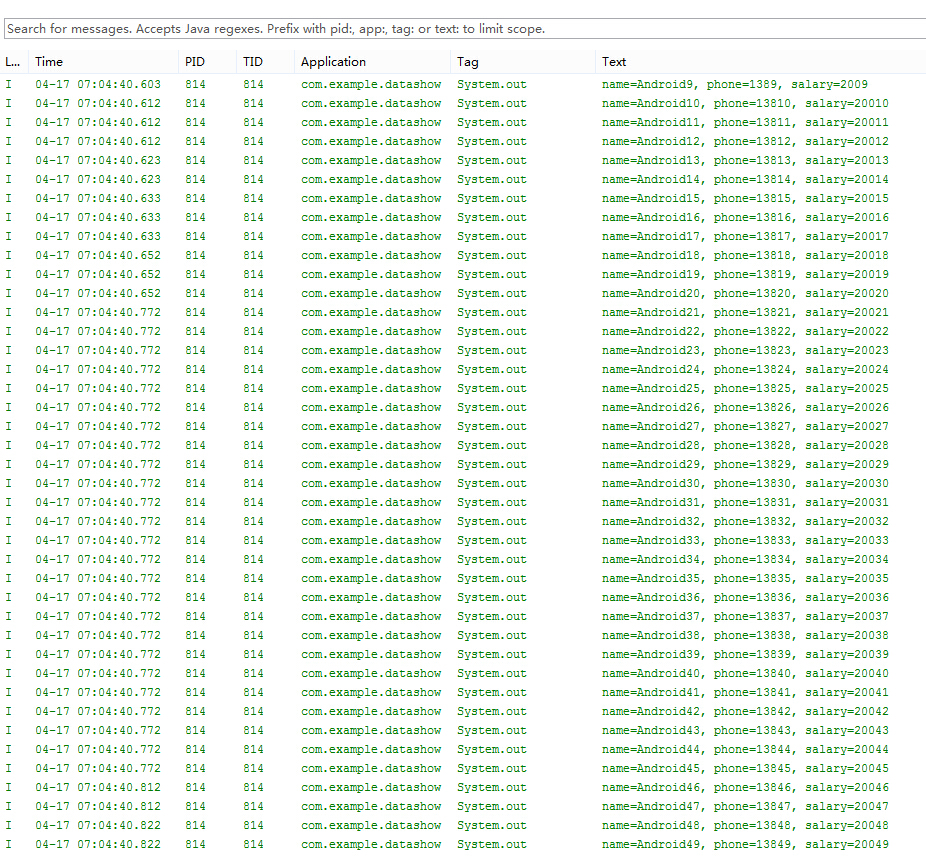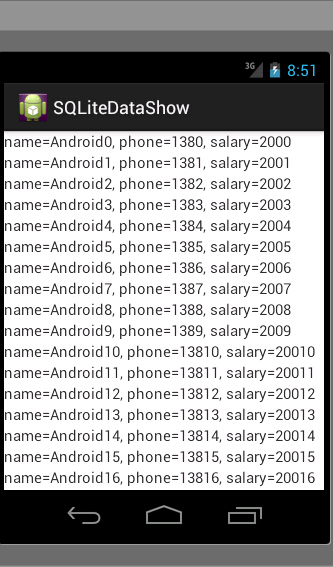菜鸟刚接触SQLite,敲了一个小Demo。用于测试SQLite。具体的SQLite的相关简介在此不再赘述。
业务描述:
使用SQLite创建数据库,并插入相关数据。最终可以在avd用户界面读取并显示数据库内容。
实现分析及步骤。
首先创建一个数据库,通过SQLiteOpenHelper进行数据库的创建,数据库创建的具体过程见后面代码。
然后对创建的数据库,进行通过ContentValues来创建数据库并插入数据库内容。由于刚接触SQLite时在进行增删改查训练时,是在单元测试框架中进行的,所以在本次Demo中,扔选择在测试框架中进行插入。
由于本次Demo用到的变量较多,(3*50=150)。为了便于对属性的管理,考虑使用JavBean来对管理属性。
最后在MainActivity中进行对数据库的查询、读取、存储和显示。
创建数据库
package com.example.datashow;
import android.content.Context;
import android.database.sqlite.SQLiteDatabase;
import android.database.sqlite.SQLiteOpenHelper;
public class mySQLite extends SQLiteOpenHelper {
public mySQLite(Context context) {
/**
* 创建一个数据库,名字为“student.db”,版本为“2”
*/
super(context, "student.db", null,2);
// TODO Auto-generated constructor stub
}
//数据库创建时,调用此方法
public void onCreate(SQLiteDatabase db) {
// TODO Auto-generated method stub
/**
* 创建数据库,一共有四列。分别为"_id", "name" , "phone" ,"salary"
*/
db.execSQL("create table student (_id integer primary key autoincrement, name char(10) ,phone char(11) , salary double(20))");
}
//数据库升级时,调用此方法
public void onUpgrade(SQLiteDatabase db, int oldVersion, int newVersion) {
// TODO Auto-generated method stub
}
}
为数据库添加内容
package com.example.datashow;
import android.content.ContentValues;
import android.database.sqlite.SQLiteDatabase;
import android.test.AndroidTestCase;
public class mySQLiteTest extends AndroidTestCase {
private mySQLite ms;
private SQLiteDatabase db;
private ContentValues newValues;
//在测试方法调用前调用此方法
@Override
protected void setUp() throws Exception {
// TODO Auto-generated method stub
super.setUp();
ms = new mySQLite(getContext());
db = ms.getWritableDatabase();
}
//测试方法结束后调用此方法
@Override
protected void tearDown() throws Exception {
// TODO Auto-generated method stub
super.tearDown();
db.close();
}
/**
* 通过ContentValues对数据库进行插入
* 对数据库插入50组数据。分别为"name","phone","salary"进行赋值
*/
public void insert()
{
for (int i = 0; i <50; i++) {
ContentValues values = new ContentValues();
//values.put("name", "A"+i);
values.put("name", "Android" + i);
values.put("phone", "138" + i);
values.put("salary", "200"+i);
db.insert("student", null, values);
}
}
}
设置JavaBean
package com.example.datashow;
public class Student {
private String name;
private String phone;
private String salary;
public Student(String name, String phone, String salary) {
super();
this.name = name;
this.phone = phone;
this.salary = salary;
}
public String getName() {
return name;
}
public void setName(String name) {
this.name = name;
}
public String getPhone() {
return phone;
}
public void setPhone(String phone) {
this.phone = phone;
}
public String getSalary() {
return salary;
}
public void setSalary(String salary) {
this.salary = salary;
}
@Override
public String toString() {
return "name=" + name + ", phone=" + phone + ", salary="
+ salary ;
}
}
MainActivity中实现
MainActivity代码实现
package com.example.datashow;
import java.util.ArrayList;
import java.util.List;
import com.example.datashow.R;
import android.app.Activity;
import android.database.Cursor;
import android.database.sqlite.SQLiteDatabase;
import android.os.Bundle;
import android.widget.LinearLayout;
import android.widget.TextView;
public class MainActivity extends Activity {
//创建一个集合用来存储数据库中的数据
List<Student> studentList;
@Override
protected void onCreate(Bundle savedInstanceState) {
super.onCreate(savedInstanceState);
setContentView(R.layout.main);
studentList = new ArrayList<Student>();
//通过SQLiteOpenHelper的继承类mySQLite来对数据库进行管理
mySQLite ms = new mySQLite(this);
SQLiteDatabase db = ms.getWritableDatabase();
//通过cursor来实现对数据库列表的遍历
Cursor cursor = db.query("student", null, null, null, null, null,null , null);
while (cursor.moveToNext()) {
String name = cursor.getString(cursor.getColumnIndex("name"));
String phone = cursor.getString(cursor.getColumnIndex("phone"));
String salary = cursor.getString(cursor.getColumnIndex("salary"));
//通过调用JavaBean对象,对Student属性赋值
Student stu = new Student(name, phone, salary);
//将stu遍历的结果存储在studentList集合
studentList.add(stu);
//用于测试Demo,实验结果将会在Logcat中显示
System.out.println(stu.toString());
}
//将数据显示至屏幕
//每有一条数据,就创建一个TextView对象
LinearLayout ll = (LinearLayout) findViewById(R.id.ll);
for (Student s : studentList) {
TextView tv = new TextView(this);
tv.setText(s.toString());
tv.setTextSize(15);
//把TextView对象设置成线性布局的子节点
ll.addView(tv);
}
}
}
布局文件main.xml代码实现
<?xml version="1.0" encoding="utf-8"?>
<ScrollView
xmlns:android="http://schemas.android.com/apk/res/android"
android:layout_width="match_parent"
android:layout_height="match_parent">
<LinearLayout
android:id="@+id/ll"
android:layout_width="match_parent"
android:layout_height="match_parent"
android:orientation="vertical" >
</LinearLayout>
</ScrollView>实现结果
Logcat结果
avd结果
至此,Demo结束。
SQLite相关内容,继续更新。
























 1720
1720

 被折叠的 条评论
为什么被折叠?
被折叠的 条评论
为什么被折叠?








